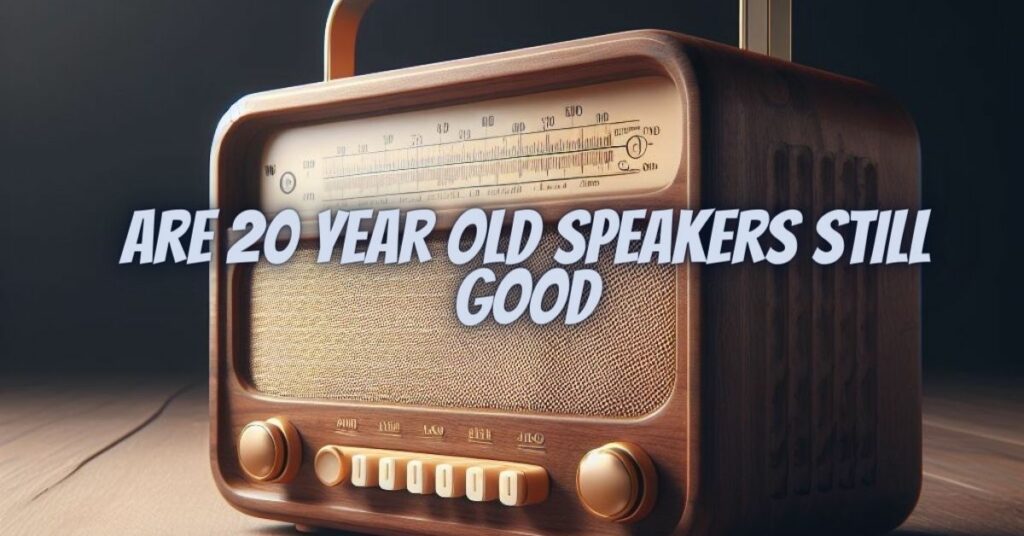Speakers are a crucial component of any audio system, and they play a pivotal role in determining the quality of sound you experience. If you’ve come across a pair of 20-year-old speakers or are wondering about the longevity of your own aging speakers, you might be questioning whether they’re still capable of delivering high-quality audio. In this article, we’ll explore the factors that determine the performance of vintage speakers, their durability, and whether 20-year-old speakers can still provide an excellent listening experience.
The Lifespan of Speakers
The lifespan of speakers can vary significantly depending on several factors, including the brand, model, usage, maintenance, and overall build quality. While speakers can last for many years, their performance may change over time. Here’s a closer look at some of the key considerations:
- Build Quality: The construction of the speaker and the quality of materials used significantly impact its lifespan. High-quality speakers with robust components tend to last longer.
- Usage: The more frequently you use your speakers and the louder you play them, the more wear and tear they’ll experience. Excessive and prolonged use can decrease the lifespan of the drivers and other components.
- Maintenance: Proper care, regular cleaning, and avoiding exposure to extreme temperatures or humidity can prolong the life of speakers.
- Environmental Factors: Speakers exposed to harsh environmental conditions, such as direct sunlight, moisture, or dust, may deteriorate faster.
Evaluating the Performance of 20-Year-Old Speakers
If you have 20-year-old speakers, it’s essential to assess their performance before making any judgments. Here are some steps to evaluate the quality of vintage speakers:
- Visual Inspection: Examine the physical condition of the speakers. Look for any visible damage, such as torn speaker cones, discolored components, or loose connections.
- Listening Test: Listen to music or audio content through the speakers. Pay attention to any unusual noises, distortion, or loss of clarity. Compare the sound to what you remember as the speaker’s original performance.
- Frequency Response: Use a frequency sweep test to assess the speaker’s frequency response. This can help identify any irregularities in how the speaker reproduces different frequencies.
- Driver Inspection: If possible, inspect the condition of the speaker drivers, including the woofer, midrange, and tweeter. Damage to these components can significantly impact sound quality.
Can 20-Year-Old Speakers Still Deliver Quality Sound?
The quality of sound from 20-year-old speakers largely depends on their condition and how well they’ve been maintained. If the speakers have been well-preserved and haven’t experienced excessive wear and tear, they can still deliver quality sound. Here are some key points to consider:
- Driver Integrity: The condition of the speaker drivers is critical. If the drivers are in good shape with no damage or deformation, the speakers are more likely to perform well.
- Crossover Components: The crossover, which directs frequencies to the appropriate drivers, should be inspected. If components like capacitors have aged or failed, they may need replacement to restore optimal performance.
- Maintenance and Care: Properly maintained speakers, including regular cleaning and protection from environmental factors, have a better chance of retaining their quality sound.
- Upkeep and Repairs: Some issues that may arise with aging speakers can be repaired. Replacing worn-out components or restoring the cabinet can extend the life and performance of vintage speakers.
- Compatibility with Current Equipment: Ensure that the speakers are compatible with your current audio equipment, including amplifiers and receivers. Older speakers may require specific connections or adjustments.
Whether 20-year-old speakers are still good largely depends on their condition and how they have been cared for over the years. Well-maintained and undamaged speakers can continue to provide excellent sound quality, while neglected or damaged speakers may require repairs or restoration. If you find yourself with vintage speakers, it’s worth assessing their condition and, if necessary, investing in any maintenance or repairs needed to revive their performance. With the right care and attention, even two-decade-old speakers can continue to deliver quality audio for years to come.


